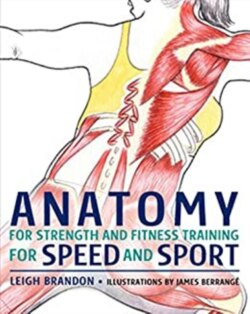Читать книгу Anatomy for Strength and Fitness Training for Speed and Sport - Leigh Brandon - Страница 7
На сайте Литреса книга снята с продажи.
ОглавлениеSYSTEMS OF THE BODY
The human body can be viewed as an integration of approximately 12 distinct systems that continuously interact to control a multitude of complex functions. These systems are a co-ordinated assembly of organs, each with specific capabilities, whose tissue structures suit a similar purpose and function.
This book illustrates and analyses the systems that control movement and posture – namely the muscular and skeletal systems, often referred to jointly as the musculoskeletal system.
The other systems are the cardiovascular, lymphatic, nervous, endocrine, integumentary, respiratory, digestive, urinary, immune and reproductive systems.
The muscular system
The muscular system facilitates movement, maintenance of posture and the production of heat and energy. It is made up of three types of muscle tissue: cardiac, smooth and striated.
Cardiac muscle forms the heart walls, while smooth muscle tissue is found in the walls of internal organs such as the stomach and blood vessels. Both are activated involuntarily via the autonomic nervous system and hormonal action.
Striated muscle makes up the bulk of the muscles as we commonly know them. The skeletal system includes the tendons that attach muscle to bone, as well as the connective tissue that surrounds the muscle tissue which is called fascia. A human male weighing 70 kg (154 lbs) has approximately 25–35 kg (55–77 lbs) of skeletal muscle.
Muscle attachments
Muscles attach to bone via tendons. The attachment points are referred to as the origin and the insertion.
The origin is the point of attachment that is proximal (closest to the root of a limb) or closest to the midline, or centre of the body. It is usually the least moveable point, acting as the anchor in muscle contraction.
The insertion is the point of attachment that is distal (furthest from the root of a limb) or furthest from the midline or centre of the body. The insertion is usually the most moveable part, and can be drawn towards the origin.
Knowing the origin and insertion of a muscle, which joint or joints the muscle crosses and what movement is caused at that joint/joints is a key element of exercise analysis.
There are typical features on all bones that act as convenient attachment points for the muscles. A description of typical bone features is given in the table on page 13.
Typical features on a bone
The word ‘skeleton’ originates from a Greek word meaning ‘dried up’. Infants are born with about 350 bones, many of which fuse as they grow, forming single bones, resulting in the 206 bones that an adult has.
The skeletal system
This consists of bones, ligaments (that join bone to bone) and joints. Joints are referred to as articulations and are sometimes classified as a separate system: the articular system.
Apart from facilitating movement, the primary functions of the skeletal system include supporting the muscles, protecting the soft tissues and internal organs, the storage of surplus minerals and the formation of red blood cells in the bone marrow of the long bones.
Integrated systems
The body’s systems are completely and intricately interdependent. For movement to take place, for example, the respiratory system brings in oxygen and the digestive system breaks down our food into essential nutrients, both of which the cardiovascular system then carries to the working muscles via the blood to facilitate the energy reactions that result in physical work being done.
The lymphatic and circulatory systems help to carry away the waste products of these energy reactions, which are later converted and/or excreted by the digestive and urinary systems. The nervous system interacts with the muscles to facilitate the contraction and relaxation of the muscle tissue. The articular system of joints allows the levers of the body to move.
The femur (thigh bone) is about one quarter of a person’s height. It is also the largest, heaviest and strongest bone in the body. The shortest bone, the stirrup bone in the ear, is only about 2.5 mm long. An adult’s skeleton weighs about 9 kg (20 lb).
